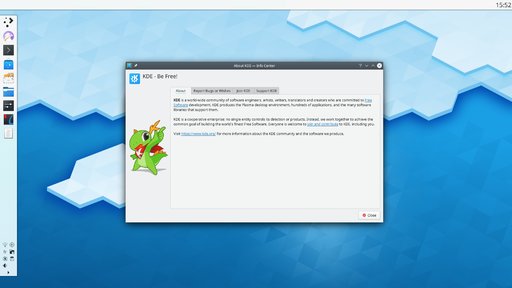Plasma/Panels/it: Difference between revisions
Importing a new version from external source |
Importing a new version from external source |
||
| Line 52: | Line 52: | ||
[[Image:Multipanel.png|thumb|512px|center|Screenshot showing a desktop with multiple panels: a vertical panel with an application launcher, shortcuts and a system tray and a second panel placed horizontally at the top of the screen with a task manager and a clock.]] | [[Image:Multipanel.png|thumb|512px|center|Screenshot showing a desktop with multiple panels: a vertical panel with an application launcher, shortcuts and a system tray and a second panel placed horizontally at the top of the screen with a task manager and a clock.]] | ||
===== | ===== Aggiungere un pannello ===== | ||
To add a new panel either click on the desktop toolbox button and select <menuchoice>Add Panel</menuchoice> or open the context (right click) menu on the desktop and select <menuchoice>Add Panel</menuchoice> from the menu. | To add a new panel either click on the desktop toolbox button and select <menuchoice>Add Panel</menuchoice> or open the context (right click) menu on the desktop and select <menuchoice>Add Panel</menuchoice> from the menu. | ||
Revision as of 18:13, 30 June 2011
Pannelli nel desktop Plasma

Un pannello è un contenitore di oggetti che può essere posizionato su ogni lato del desktop. Possono esserci più pannelli sul medesimo lato. La disposizione predefinita prevede un pannello che occupa tutta la parte bassa del desktop con i seguenti oggetti: menu delle applicazioni, cambia desktop, gestore dei processi (elenco delle finestre aperte), vassoio di sistema, notificatore dei dispositivi e orologio. Se stai utilizzando un portatile, un netbook o un altro computer dotato di batteria, nel pannello ci sarà anche un oggetto per la gestione energetica. All'estremità del pannello c'è una casella degli strumenti che può essere attivata per accedere alle opzioni di configurazione.
Configurazione
Il pannello può quindi essere configurato facendo clic sulla casella degli strumenti che si trova a destra per i pannelli orizzontali o in basso per quelli verticali. A questo punto il pannello è in modalità di configurazione. Si può anche accedere alla configurazione del pannello tramite il menu contestuale (clic destro) del pannello.

Gli oggetti nel pannello possono essere ordinati trascinandoli quando si è in modalità di configurazione. Gli oggetti si allineano a sinistra nel pannello orizzontale e in alto in quello verticale.
La casella degli strumenti del pannello
- : ti permette di trascinare il pannello in uno qualsiasi dei quattro bordi dello schermo.
- (per il pannello orizzontale): permette di regolare l'altezza del pannello.
- (per il pannello verticale): permette di regolare la larghezza del pannello.
- : permette di aggiungere oggetti al pannello.
- : ti permette di aggiungere uno spaziatore nel pannello che distanzia gli elementi tra cui viene posto.
- Il comportamento standard di uno spaziatore prevede l'utilizzo di tutto lo spazio possibile (dimensione variabile), ma puoi anche impostarlo ad una apri il menu contestuale (clic destro) e disattiva .
- : permette di impostare l'allineamento del pannello in tre posizioni preimpostate.
-
- : Keeps the panel visible at all times, even when windows are maximised.
- : Hides the panel off screen until the mouse is placed near the screen edge.
- : This allows windows to cover the panel and if maximised, will cover the panel.
- : This allows windows to go below the panel, even when maximised.
- : Makes the panel fit to the screen edges, if it has been resized.
- : Locks the panel and widgets in position. Also hides the toolbox.
- : Removes the current panel and all widgets in it.
Più pannelli
It is also possible to have more than one panel on your desktop. This proves useful if you want to have a more flexible layout:

Aggiungere un pannello
To add a new panel either click on the desktop toolbox button and select or open the context (right click) menu on the desktop and select from the menu.
If more than one kind of Panel is installed, you will be able to select between them to choose what sort of Panel you would prefer. By default, two Panel types are available: , which creates a Panel containing all of the default widgets (launcher, pager, tasks, system tray, clock, etc.), and , which adds an empty Panel without any pre-configured widgets in it.
Locking
The panels and desktop may be locked to prevent changes being made to them. When locked, the toolbox buttons will not be shown on either the desktop or on the panels. To configure a panel, it must be unlocked, otherwise the toolbox and context menu entries to configure or add widgets are unavailable.
Locking can be done by either selecting the entry in the Panel toolbox's menu or in the Panel context (right click) menu. Once locked, the Panels can be unlocked again by right clicking on either a panel or desktop and selecting from the menu that is displayed.
